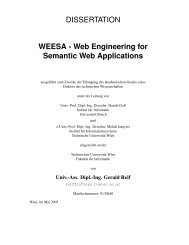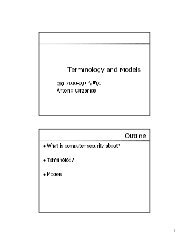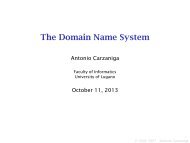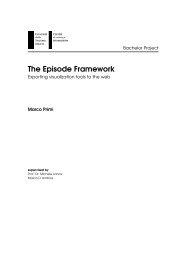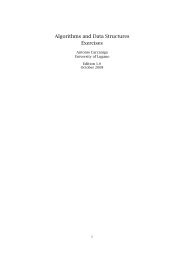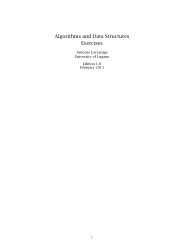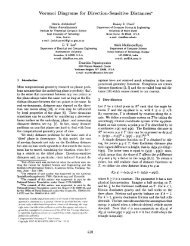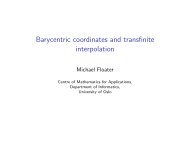Extractive Summarization of Development Emails
Extractive Summarization of Development Emails
Extractive Summarization of Development Emails
You also want an ePaper? Increase the reach of your titles
YUMPU automatically turns print PDFs into web optimized ePapers that Google loves.
method the terms were ordered by decreasing score and the top five were considered to build the summary. Thus<br />
they discovered that pieces <strong>of</strong> source code can be automatically summarized using text retrieval techniques.<br />
For what concerns this document, we appreciate the extractive approach, and the choice <strong>of</strong> using graduate<br />
students for the experiment.<br />
2.3 <strong>Emails</strong><br />
<strong>Emails</strong> constitute a composite, chronologically ordered, and structured (due to the many fields they have, like author,<br />
subject, date, body, ...) material that can be summarized with many different methods: either with an abstractive<br />
approach or an extractive one, considering either a single email or a complete thread, extracting either keywords or<br />
sentences, using either determinism or non-determinism.<br />
Carenini et al. [4] proposed a schematic and synthetic solution: creating a "fragment quotation graph" that<br />
captures the core <strong>of</strong> the conversation, by using clue words to measure the importance <strong>of</strong> each sentence. Their idea<br />
was that by exploiting quotations in emails, a good structural representation <strong>of</strong> the conversation could be provided.<br />
A fragment quotation graph G = (V, E) is a directed graph where each node u ∈ V is an email in the folder,<br />
and an ordered edge (u, v) means that node u replies to node v. They defined the quotation depth <strong>of</strong> a line as the<br />
number <strong>of</strong> quotation markers ">" in the prefix. Assuming that "any new fragment is a potential reply to [...] quoted<br />
fragments immediately preceding or following it", an edge is added between such neighboring nodes.<br />
A clue word from a node in this graph is a stemmed term that is contained also in its parent node(s) and/or its child<br />
node(s). They also used the concept <strong>of</strong> hidden email, which is an email quoted by at least one email in the folder<br />
but not present. If a fragment is a hidden email, edges are created within the neighboring block.<br />
Once terminated the construction <strong>of</strong> the graph, they used it to determine the most relevant keywords to be<br />
included in the summary. The assumption was that words strictly related to the current topic would occur more<br />
frequently in successive replies. Thus they built a tool called ClueWordSummarizer that determined the score <strong>of</strong> a<br />
given word with the statistical formula:<br />
∑<br />
∑<br />
ClueScore(CW, F) = f req(CW, parent(F)) + f req(CW, child(F))<br />
parent(F)<br />
child(F)<br />
Afterwards they set up a user study to evaluate the extractive summaries produced by ClueWordSummarizer,<br />
managed as follows:<br />
1. They selected 20 email threads from the Enron email dataset 4 .<br />
2. They hired 25 undergraduate or graduate human summarizers.<br />
3. Every person reviewed 4 conversations in 1 hour (so each conversation was reviewed by 5 different summarizers).<br />
4. A humanly generated summary had to contain 30% <strong>of</strong> the original sentences.<br />
5. Every selected sentence had to be classified either as essential or optional.<br />
6. They assigned a score to each sentence to evaluate it according to human selection.<br />
From this study they discovered that, sorting the sentences by the attributed score, 17% <strong>of</strong> the ones in top-30%<br />
sentences belonged to hidden mails. Therefore this kind <strong>of</strong> emails contains relevant information that should be<br />
included in a summary.<br />
In our opinion, the main drawback <strong>of</strong> this approach is that they exploited only deterministic characteristics<br />
proper <strong>of</strong> the email structure, without considering, for the extractive operation, frequent features found in human<br />
generated summaries. Anyway, we consider valid the extractive approach, the choice <strong>of</strong> using graduate and undergraduate<br />
students for the experiment, the idea <strong>of</strong> limiting the length <strong>of</strong> the summaries written by annotators, <strong>of</strong><br />
dividing selected sentences into essential and optional, and using this to assign a score to every sentence.<br />
Lam et al. [7] proposed a system to summarize email messages by exploiting thread reply chains and commonlyfound<br />
features (like the proper names in subjects found in the main sentences <strong>of</strong> the body). Such system used<br />
heuristics to remove email signatures, fields and quoted text, and to identify names, dates and companies cited in<br />
the email by using regular expressions and training data. If an enclosing email thread exists, this algorithm processed<br />
the email ancestor to have additional information about the context. Even though choosing to summarize only the<br />
4 http://www.cs.cmu.edu/~enron/<br />
6



